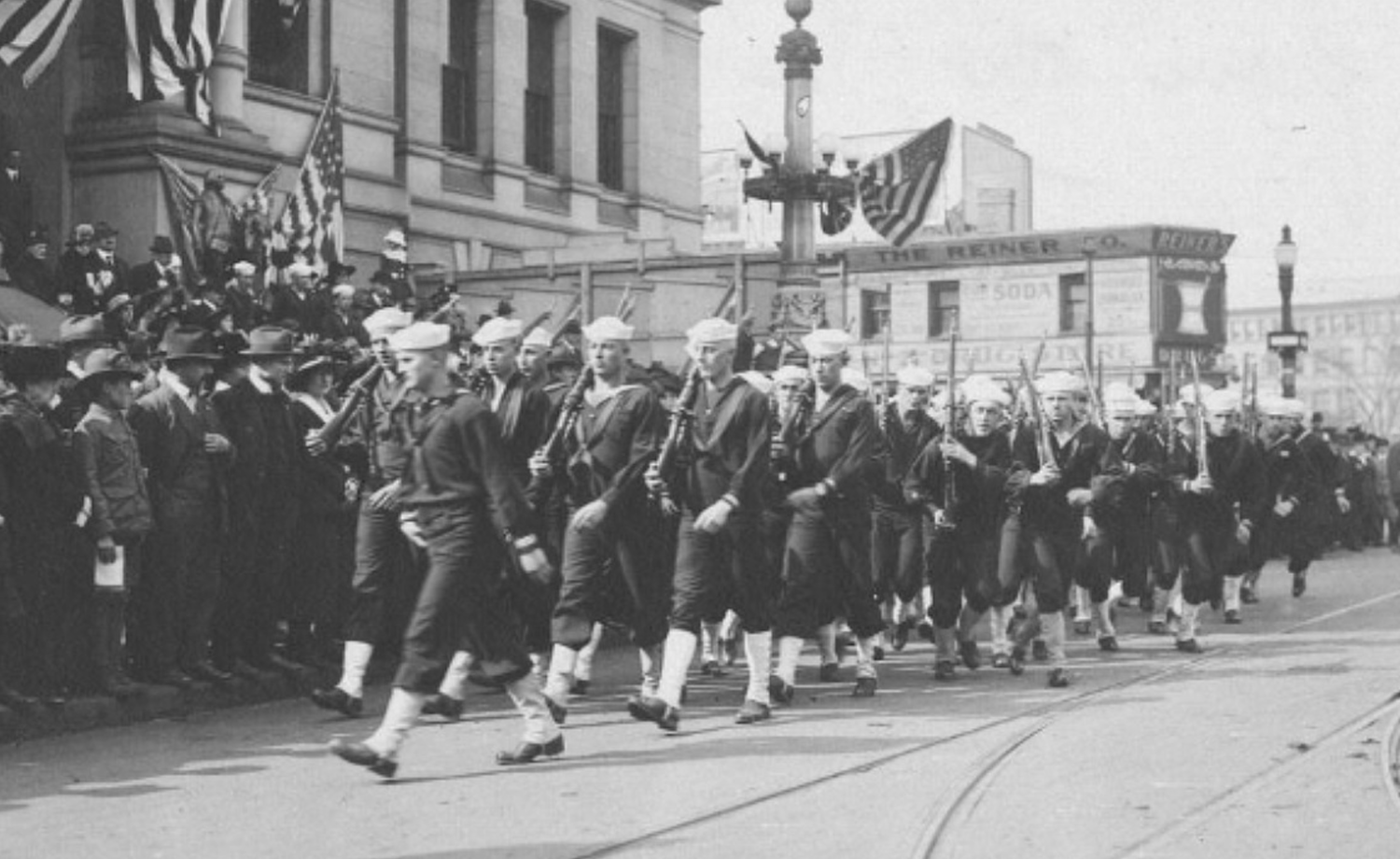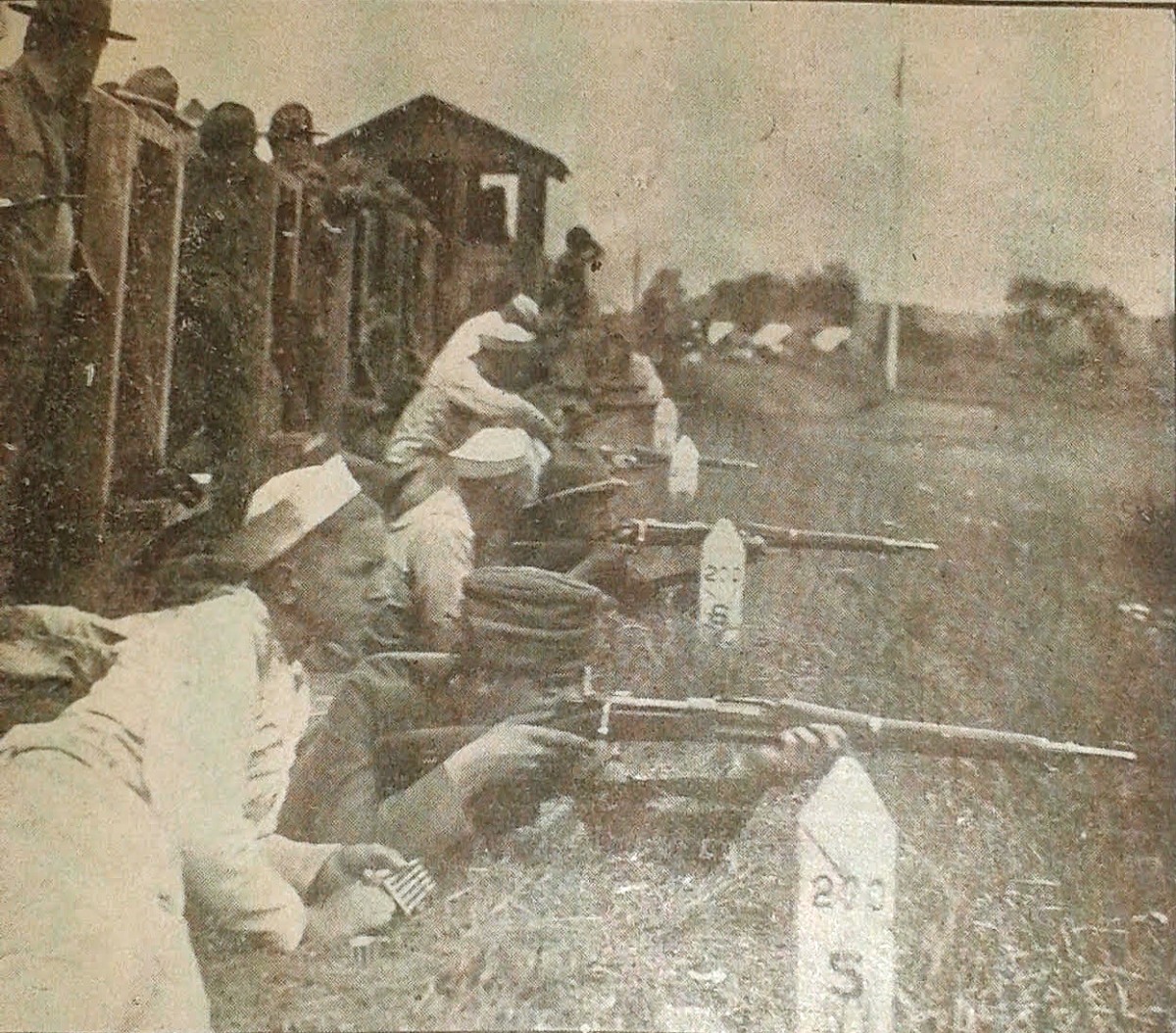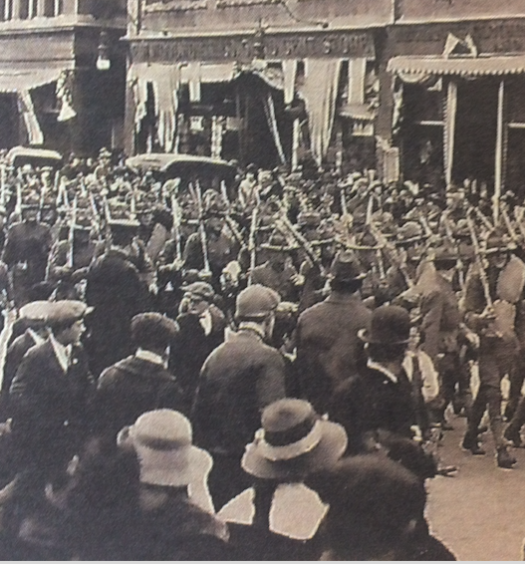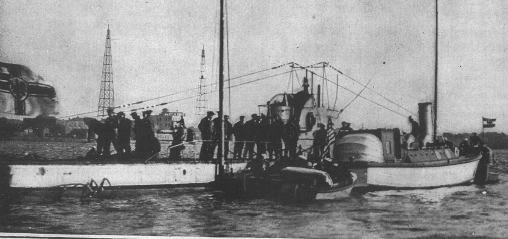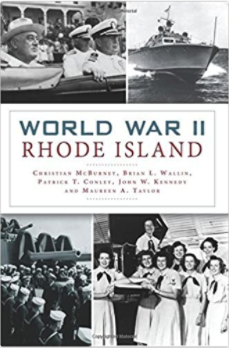When the United States declared war on Germany and Austria-Hungary on April 6, 1917 and entered the Great War, it created an urgent need to train members of the armed forces. Under the powers granted by the National Defense Act of 1917, the armed forces sought out pre-existing firing ranges in order to expedite the training of riflemen. One such firing range, albeit a small one, had been built in Rumford by the Rumford Chemical Company and was being leased to the state guard for training purposes. In accordance with the powers granted it by the aforementioned Federal Decree, the U.S. Navy quickly executed a lease with the state guard to take over the Rumford Range. Wasting no time, on April 30, 1917, the first contingent of thirty-five sailors arrived at the range to start setting up operations.
A single building existed at the site which would serve as their mess hall, administrative building, barracks, and storehouse until new buildings for those specific purposes could be erected. The Navy staff first addressed where to build sanitary facilities and a fireplace for cooking.
The very next day after their arrival, on May 1st, sailors began working by hand, in accordance with Federal blueprints, what would eventually become, 200, 300, 500, and 600 yard firing ranges. Thirty-two were built with steel target frames and electrically operated targets, including rifle, pistol and machine gun ranges.
Eventually more sailors arrived bringing the total to fifty-five. They were expert riflemen, instructors and range builders, the forerunners of the Seabees established in World War II. They set up a canvas tent city until buildings could be erected. By doing so, Rumford became one of the first Navy training ranges to train men with rifles, pistols and Lewis & Browning machine guns.
An assignment to the Rumford Rifle Range for a sailor for training was informally referred to as temporary additional duty (TAD) to the USS Rumford. The assigned sailors were called locally as Rumford Sailors. Formally, they received the title, The Permanent Force at the Rumford Rifle Range.
The local community went out of their way to welcome, embrace and entertain the sailors. The sailors published a bi monthly gazette called The Trigger, which contained articles about local social events, supported by local advertising. By November 1918, an impressive 15,000 copies of the newspaper were being printed, an increase of 2,000 from the prior month. The Knights of Columbus erected a 80 x 40 building, for the permanent force at Rumford, which was dedicated with much fanfare. Speakers at the dedication were Lt. Governor San Souci, the president of the town council of East Providence, and the pastor of St. Margaret’s. The dedication was held on November 10th, 1918, the day before the Armistice was declared. Within the building, sailors could read, write letters, play games, play music, showed silent movies, and hold dances. All kinds of organizations within a twenty mile radius vied to provide activities for the Rifle Rangers. St. Margaret’s Church, the Gladiola Club, and the Hunts Mills all held dances for the sailors.
The Navy eventually built several substantial buildings at the Rifle Range: three large barracks near the pond; a mess hall capable of accommodating four hundred sailors at a time; officers’ quarters; a range house; and an administrative office building. Telephone booths were eventually built on site for the convenience of the sailors.
New buildings included a state of the art hospital complete with a medical staff headed by a Navy Doctor, Lt. C.C. Emery. The hospital included a dispensary, reception rooms, an office, wards, a storeroom, and a large sunporch overlooking the rifle range. It was a one story building described as having white enamel walls throughout. This fine facility was put to good use when the range was stricken with the deadly Spanish flu, part of the worldwide pandemic. Seventeen cases broke out; stricken sailors were treated at the hospital and then moved to Rhode Island Hospital or St. Joseph’s Hospital in Providence. The Newport Naval Hospital was plagued with its own outbreak.
During the Great War, the Navy operated eleven rifle ranges throughout the country. Rumford became one of the first Navy ranges to offer training with a rifle, pistols, and machine guns. On a typical day, the Rumford Range was training upwards of 500 sailors at a time, along with state guardsmen. Each man had his own instructor coaching in in all aspects of the Springfield service rifle. It held twenty rounds and five shots were to be taken in each of the following positions: sitting, squatting, prone and kneeling. Because each man did this on the 200, 300,500, 600, 800, and 1000 yard ranges, with a rifle, pistol, and machine guns, the training regimen at Rumford typically lasted ten days. Munitions used at the range were .22., .30, .38, .45, and .50 caliber bullets, along with tear gas grenades (Mk II) and rifle grenades (white phosphorus smoke Mk I). The target range was operational weekdays from 7:30 a.m. to 5 p.m., and also part-time on Saturdays and Sundays.
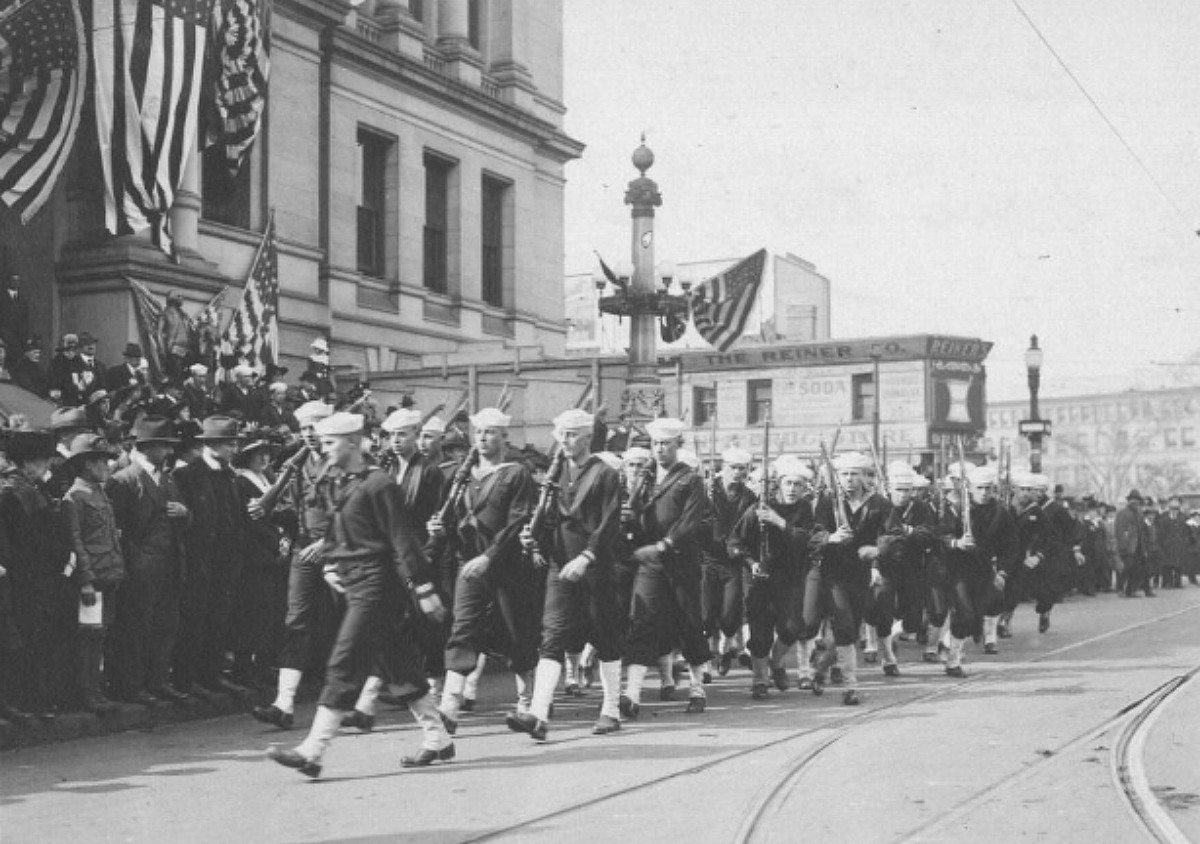
Sailors from the Rumford Rifle Range march in front of the Providence City Hall with the Biltmore Restaurant on the corner in back (National Archives).
Virtually all of the sailors from all the commands of the second Naval District were rotated through the Rumford Range for training. A permanent force of 300 hundred sailors for training and support remained behind.
In May, 1918, R.I. Governor Beekman said that he was pleased to have the Rumford Rifle Range available to train members of the state guard, state and local police, along with any male private citizen who wanted to avail himself to the instruction of Navy coaches at the range at absolutely no charge. The training would be on the very latest Springfield and Enfield rifles. As for the male citizens only requirement, it was still 1918, and women still did not yet even have the right to vote.
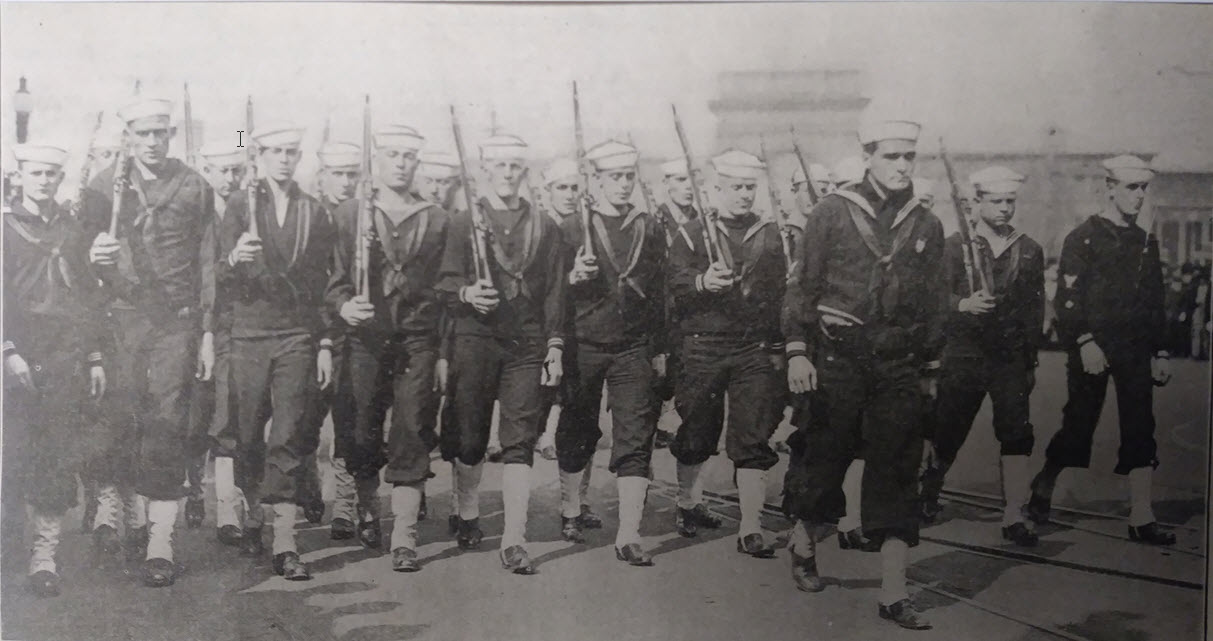
“Pride of Rumford Show ‘Teddy’ How a Battalion Should Drill” (possibly again in downtown Providence) (The Trigger, Nov. 2, 1918, Collection of Michael Reynolds of East Providence)
Sailors commonly expressed the opinion that that they had “the time of their lives” at Rumford as. They also had one universal complaint about their stay: the infernal plague of mosquitoes.
In off-hour activities, the permanent force stationed at the rifle range formed a football team of former players that was good enough to play the Providence Steamrollers, a local professional football team that was state champion the prior year, and win 21-9 (despite “rough house tactics on the part of the losers”). The hastily put-together gridiron team also played against Brown University’s squad, which had been a national powerhouse in 1915 and 1916, but by 1918, the college team was depleted by students entering the military. Thus, while my research does not indicate which side won, the Rumford Rifle eleven likely defeated Brown too. The permanent force also had a drill team that put on demonstrations for charity fundraisers.
The Great War came to an end on November 11, 1918. Soon thereafter, the Rumford Sailors received their orders to pack their sea bags and demobilize as of December 31, 1918. A special commemorative edition of their semi-monthly journal, The Trigger, was produced about the permanent forces stay at Rumford. Among the accolades that the sailors heaped on Rumford and Rhode Island was this endearing quotation: “We could not leave this town where we have spent the most pleasant eighteen months of our lives without first saying to this town and its people, good-bye Little Rhody, good bye Rumford, friends of our early manhood. The permanent force bids you farewell.” When the Navy departed, the recreation hall, built by the Knights of Columbus, was moved to property owned by St. Margaret’s Church and used for youth activities until it was dismantled in 1936.

The Rumford Rifle Range’s football team beat the Providence Steamroller’s, the local professional squad (The Trigger, Nov. 2, 1918, Collection of Michael Reynolds of East Providence)
The Navy did not entirely abandon Rumford. It temporarily relinquished control of it to the state guard for training purposes. The Navy returned once more June 2, 1920, when a boat arrived at Phillipsdale Landing from Newport Training Station with 250 members of the crew of the USS Tennessee battleship for rifle training at Rumford. It was reported that the crew marched in unison from the dock to the range. The shortest route for the march could have been the one they took: from Phillipsdale Landing up Bourne Avenue to Hoyt Avenue down to and across Pawtucket Avenue to what is now Ferris Avenue and then on to the nearby range.
In May 1922, the lease on the range property expired and its renewal was declined. The General Assembly passed a bill allocating $27,500 for the outright purchase of the of the 101.7 acres, and Governor R. Livingston Beekman signed it into law. With that the range became state property. The state militia, later about 1940, the National Guard, used it for training purposes until 1946. According to Frank Titus, now 87-years, a lifelong resident of the Rumford neighborhood near the rifle range, the state guard used the site for training purposes, including for practice using Molotov cocktails on wrecked and abandoned cars brought to the site as targets. Frank also remembers that anti-aircraft guns along with searchlights were used at the range for training during World War II.

Cover of The Trigger, November 2, 1918, the newspaper published for the Rumford Rifle Range (Collection of Michael Reynolds of East Providence)
Between 1896, the earliest record I have seen for state guard use, and the range’s final closure in 1946, it is fair to say that literally tens of thousands of rounds of ammunition were expended at this site. The ordinance strewn over the target fields left a treasure trove of sorts for the local kids. Michael Reynolds, who grew up in the neighborhood of the range and played there as well, informed me that he, as well as many other children in the area, would go there and collect lead and brass shell casings, which in turn were purchased by the local junk man, thereby providing the kids with candy money. Ann Linde also lived in the neighborhood as a child and recalls doing the same thing. (Michael has been instrumental in identifying the remains of the range for me.)
In 1949, the state owned rifle range was recommended by the site subcommittee of the East Providence school board as a suitable location for a new elementary school. It became the Thompson School and much of the target range later became the Kimberly Rock playing fields. Today the story of the Rumford Rifle Range is but a faint memory in local history.
[Banner image: Sailors from the Rumford Rifle Range march in front of the Providence City Hall with the Biltmore Restaurant on the corner in back (National Archives)]
Sources:
Author’s Interview with Frank Titus, lifelong resident of Rumford, April, 2017
Author’s Interview with Michael Reynolds, childhood resident of Rumford, April, 2017
Author’s Interview with Ann Linde, childhood resident of Rumford, February 15, 2017
Providence Evening Bulletin, April 25, 1959, p.14
Providence Journal, July 14, 1918, p. 55
Providence Journal, November 18, 1918, p. 51
Providence Journal, January 18, 1918 p. 1
Providence Journal, May 10, 1918, p.16
Providence Journal, June 6, 1920, p. 1
Providence Journal, January 1, 1919, p. 2
Providence Journal, June 5, 1920, p. 18
Providence Journal, July 4, 1918, p. 13
Providence Journal, September 8, 1922, p. 13
Providence Journal, October 12, 1949, p. 25
Providence Journal, June 25, 1950, p. 27
Providence Journal, December 4, 1956, p. 21
The Trigger, Oct. 3, 1918, Collection of Michael Reynolds of East Providence, RI
The Trigger, Nov. 2, 1918, Collection of Michael Reynolds of East Providence, RI

